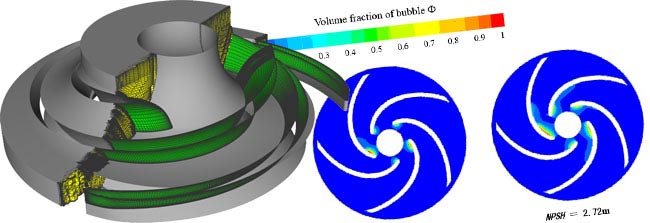Predicting Cavitation in Centrifugal Pumps through CFD
Posted by: Mehul Patel | Posted on: December 15th, 2014
Cavitation is a widely known problem associated with pumps, causing severe impact in overall performance as well as malfunctioning due to improper pump inlet conditions. As such, it is highly important for a pump user to know what cavitation is, its effects and possible ways of controlling it using modern simulation techniques such as CFD. The use of CFD permit incorporating design changes in the early development phase of the product, thereby considerably reducing the time-to-market.

The Cavitation Phenomenon:
Cavitation can be defined as a process of generation and destruction of the vapor phase of a liquid subjected to low and high pressures simultaneously at constant ambient temperatures. It is a thermodynamic change of state with mass transfer from liquid to vapor and vice versa, i.e. bubble formation and collapse.
In case of pumps, cavitation occurs mainly due to sudden increase in local velocities creating low pressure pockets, resulting in local evaporation of the liquid and formation of two phase (liquid-vapor) flow. Once the local velocities slow down and the static pressure is raised above the vapor pressure, the bubbles formed implode, generating noise and physically damaging the nearby solid surfaces in severe cases.
Evaluating Cavitation:
The Cavitation behavior can be expressed in terms of cavitation parameters such as cavitation number (σ), Net Positive Suction Head (NPSH) and Thoma Cavitation number (σTH). In general, cavitation performance is related to critical values of NPSH, which is a measure of how close the fluid at a given point is to boiling inside the pump. When the available NPSH is more than the required or critical NPSH, the formation of cavitation is less. Cavitation is a key design consideration for pump design and its prediction allows identifying when and how much cavitation can be expected, in order to evaluate whether this might cause operational troubles.
CFD to Predict Cavitation:
The role of CFD is significant in predicting the first appearance of cavitation known as incipient cavitation. To determine this incipient cavitation, there are three different methods, which include:
- Flow visualization
- Hydro-acoustic noise measurement
- Numerical flow simulations
Visualizing flow requires costly test setup, while hydro-acoustic measurement is less accurate despite being cost-effective. Numerical simulation as such is the most economical and accurate way when used with proper engineering knowledge and care against errors. A typical CFD simulation for cavitating flow can be solved by using multiphase model and a standard k-ε turbulence model. Velocity inlet and pressure outlet can be assigned as boundary conditions and the cavitation condition can be adjusted by changing the output pressure. In order to initialize the solver, single phase and steady flow conditions can be applied. Once the flow equations are solved, the results can be utilized to predict the cavitation curve.
In order to develop the cavitation performance curve, the available pressure head and NPSH can be calculated under different output pressure conditions. The required cavitation margin according to the standard authorities is the value of NPSH when the pressure head decreases by 3%. It can be observed in the simulation results that the volume fraction of bubble near the center of the impeller channel increases and shows signs of extension when NPSH is 2.72m. Additionally, pressure and velocity contour plots can also be used to identify mass flow rates that reduce pressure head and give rise to cavitation.

About Author: Mehul Patel specializes in handling CFD projects for Automobile, Aerospace, Oil and Gas and building HVAC sectors. He works as a CFD consultant with Hi-Tech CFD for the past 5 years and has successfully executed numerous CFD projects of high complexities. He is an expert in turbo-machinery, gas dynamics, Combustion, Fluid Dynamics, multiphase flow analysis, computational fluid dynamics etc.
